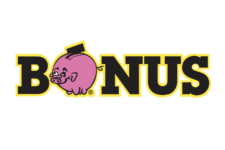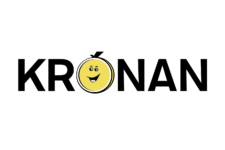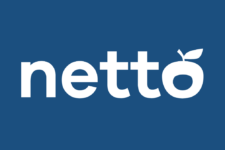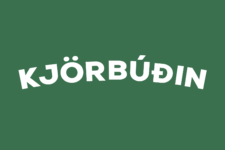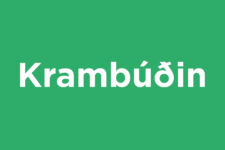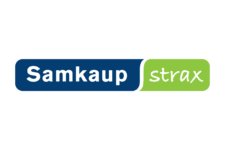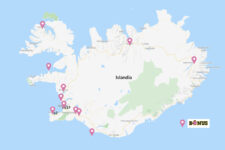You’ll do basic grocery shopping in practically every village in Iceland, but you’ll find the widest assortment of products and the lowest prices in grocery supermarkets, of course. But which stores are the cheapest? Which products are relatively cheap and which ones are rather expensive? Finally: what is worth (and allowed) to bring with you to Iceland? These questions are answered in this guide.
Remember that you can find more information about prices for other products and services in Iceland in this article: Prices in Iceland: How Much Is Food, Fuel, Tours.
Information about local delicacies and recommended restaurants are collected in the article Iceland for Foodies – What’s Worth Trying and Where.
And we’ve gathered additional information about the specifics of cooking on your own in Iceland here: Self Catering in Iceland – All You Need to Know.
Grocery store networks in Iceland
You will find some kind of grocery store in practically every village in Iceland. Of course, most of them are in and around Reykjavik, but you’ll also find smaller or larger grocery stores everywhere else (except the interior).
The mainstay of your shopping should be large grocery stores of one of the national chains. There, not only the selection of goods is widest, but also the prices are the lowest, and this can, after all, can make quite a difference in the cost of the entire trip, if you’re on a budget.
Large supermarket chains
The main chains of Iceland’s largest supermarkets are Nettó, Krónan and Bónus. Netto and Kronan are quite similar to each other – they are large and offer products from a plethora of categories, as well as a wide selection of products in each of these categories.
The same cannot be said about the third large supermarket chain: Bonus. This is clearly a different one. The stores are smaller and the selection of category products, as well as products within a category, is quite limited. For Bonus is all about low prices. And they are indeed low, but you’ll find no premium products here, (almost) no well known brands and product selection is often non-existent.
There is a Costco shop in southern Reykjavik (Kauptún 3, 210 Garðabær, Iceland; open 10 AM – 9 PM most days), too, but that’s not relevant for most tourists.
Smaller grocery stores
Iceland also has quite a number of somewhat smaller chain stores – Kjorbudin (Kjörbúðin) and Krambudin (Krambúðin). These are stores with a smaller selection of items and higher prices, but their advantage is their universality or accessibility. These are the stores you’ll find in smaller towns throughout Iceland. In addition, Krambudin chain stores are generally open the longest.
Alcohol, on the other hand, is sold exclusively by a separate, dedicated, state-owned store chain – Vinbudin – which you will read more about at the end of this article.
Outside Reykjavik and the southwestern part of the island, these largest and least expensive markets are rather few and far in between. This is true even at the island’s main ring road – Route 1. For example, when you drive east from Vik, where there is a Kronan market, it is as far as 272 km / 170 mi to the next town with a large store (Höfn, Netto store). So distances can be long, but realistically there is no problem finding such a store every 2-3 days.
I
celand’s interior is a beautiful, but completely wild land; there are no grocery stores (or gas stations!), and the hostel and camping stores offer very narrow selection of products at (understandably) inflated prices. So do your shopping prior to entering the interior.
Opening hours of grocery stores in Iceland
Store working hours are another important factor. After all you want to spend your days sightseeing, not shopping (correct?).
In principle, all major grocery stores in Iceland are open at least between 10 AM and 7 PM all week long (including holidays!).
If you need to shop outside these hours, look up the chain you are interested in individually. Links to sites with official business hours are provided in the footnotes to the table below. Google Maps is also quite precise and up-to-date with individual store opening hours, so you can look them up there as well.
S
ummer days in Iceland are really long. In June there is basically no night, in May or September it doesn’t get dark until around 10 PM. Consider using it to your advantage – arrange your day opposite to most tourists: do your shopping in mid day, and see the waterfalls at 8 or even 10 PM. You will avoid the worst of the crowds in both places.
| Opening hours of grocery stores in Iceland |
|
Bónus 1) |
Nettó 2) |
Krónan 3) |
Kjörbúðin 4) |
Krambúðin 5) |
| Mon. – Fri. |
10 AM – 8 PM |
10 AM – 7 PM |
9 AM – 9 PM |
9 AM- 6 PM |
8 AM – 11:30 PM |
| Saturday |
10 AM – 8 PM |
10 AM – 7 PM |
9 AM – 9 PM |
10 AM – 5 PM |
9 AM – 11:30 PM |
| Sunday |
10 AM – 8 PM |
10 AM – 7 PM |
9 AM – 9 PM |
12 PM – 5 PM |
9 AM – 11:30 PM |
Opening hours of individual stores may vary slightly. See footnotes below the table.
Table: Basic operating hours of the chain’s main stores in Iceland.
Notes on store opening hours 1) - 5) (click to expand)
- Some Bonus chain stores are open from 10 AM to 7 PM: Akranes, Vestmannaeyjar, Tungata, Stykkisholmur and in Reykjavik on the following streets: Garðatorg, Lóuhólar and Skútuvogur. Several stores in this chain operate at different hours, depending on the day of the week. These stores are: Egilsstadir, Isafjordur and in Reykjavik at Kringlan (shopping center). You can find detailed operating hours for each store here: Bónus – Opnunartímar
- Netto markets at Fiskislóð 3 and Þönglabakka 1 in Reykjavík are open 24/7. Markets in Selfoss, two in Kopavogur (southern Reykjavik), Lagmula, Keflavik, Hafnarfjörður and Akureyri are open daily until 9 PM. For details, click here: Verslanir Nettó
- Some Kronan stores are open only until 8 PM, these include stores in Akranes, Mosfellsbær and Selfoss, and a few in Reykjavik (at Skogarlind 2, Fiskislóð 15, Bíldshöfði 20 and Háaleitisbraut 68). A few also have shorter weekend hours – these are stores in Hvolsvöllur, Reyðarfjörður and Þorlákshöfn. Detailed, up-to-date information about each store can be found here: Verslanir Krónan
- The Kjörbúðin store in Hella is open a little longer: 9 AM – 8 PM during the week, 9 AM – 6 PM on Saturdays and 9 AM – 5 PM on Sundays. For up-to-date information on opening hours and store addresses, click here: Kjörbúðin verslanir og opnunartímar
- The Krambudin stores in Akureyri (at Borgarbraut 1) and in Keflavik (Hringbraut 55) are round-the-clock stores. The others have quite varied opening hours – see them here: Verslanir Krambúðirnar
Food prices in Iceland: what’s expensive and what’s relatively cheap
How expensive is food in Iceland? Which products are the most expensive and which are the cheapest?
Video: Prices of basic items in Icelandic stores.
Food prices vary a lot across countries, but in above video we compare them to those in Poland, which should be quite representative to Central Europe, but clearly lower than those in Western Europe and USA.
Food products in supermarkets are on average about twice as expensive in Iceland as they are in Poland. Many products are up to three times more expensive, but some can be found at prices even a tad lower. The most expensive product categories in Iceland (comparatively) include chicken breast, cream cheese, camembert cheeses, cold cuts, apples, oranges and bread. See more details below.
Bread prices in Iceland
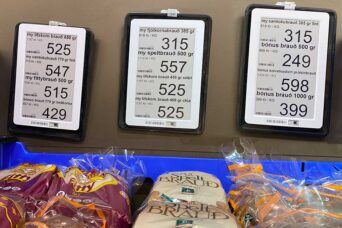
Bread prices in Iceland
You can get some reasonably priced bread in Iceland, but that will mostly be toasts or toast bread. The absolute cheapest bread we could find in Iceland was toast bread at Bonus – bonus braud. It costs 399 ISK, or about $3, for a 1 kg package. So that’s at least twice as cheap as any other bread in Iceland, but still quite expensive compared to [quality bread in] other European countries.
Most kinds of breads, buns and rolls are priced at around 1,000 ISK ($7) per kilogram (see Bonus prices in the photo: about 300 ISK for 300 g or about 500 ISK for 500 g). Prepare to pay close to $10 per loaf, if you’re looking for quality bread…
Which stores in Iceland are the cheapest
A fairly common opinion is that for the lowest prices in Iceland you must go to Bonus stores. And there is some truth in this, but certainly exaggerated, especially when you compare Bonus to Kronan.
Comparing prices between chains is quite difficult, because it’s hard to find the same products and in the same weight, size, variant etc. Indeed, Bonus often offers the lowest price for a given type of product, but this is usually done in one of the following ways:
- diminished quality (like ham that’s 38% water);
- large quantity packaging (bacon in a 1 kg package);
- not offering products that would have to be more expensive (better breads, camembert cheese, pesto);
- technical price reduction of 1 ISK (less than a cent);
The Bonus chain offers a narrow selection of products, usually in large packages, and you will find almost no brand-name products there (breakfast cereals are perhaps the only exception). At the same time, prices at Bonus are only about 10% lower than at Kronan, and at Kronan we have a tremendously larger selection of virtually everything.
Prices in Netto – on average – are up to 30% higher than in Bonus. This looks like a big difference, but it largely comes from categories where Netto offers only high-quality / top brand products and has no cheap private label. Such categories include pasta or rice sauces, for example. If we look only at products that are almost identical across all chains, Netto’s prices are at most a tad higher than those of the competition.
Additionally it seems that whenever one manages to find the exact same product in the stores of different chains, it is indeed the cheapest at Bonus, but its price there is often lower by literally 1 ISK, so far less then a single cent (that’s milk, for example).
| The differences are sometimes minimal |
| Product |
Bonus |
Kronan |
Netto |
milk
(1l carton) |
198 ISK |
199 ISK |
199 ISK |
ground cucumbers
(1 piece, 350 g) |
215 ISK |
216 ISK |
229 ISK |
eggs
(10 pcs.) |
659 ISK |
680 ISK |
659 ISK |
chicken breast
(1 kg) |
2395 ISK |
2399 ISK |
2549 ISK |
Data as of February 2023. 1 USD = 135 ISK, 1 EUR = 150 ISK
Table: Price comparison of selected food items (2023)
Note: $1 is about 135 ISK and 1€ is about 150 ISK. So 1 ISK is worth less then 1 cent or eurocent.As you can see milk, cucumbers, eggs or meat prices are indeed lowest at Bonus, but if the difference is often less than a single cent, than what difference does it make?
All
in all Bonus is the least expensive, mostly because it only sells low-cost variants or products in any category. Similarly Netto is the most expensive, largely because it offers only the high quality products/variants/brands. And Kronan “sits in between” because it strives to offer best of both worlds.
Therefore, if your priority is to save money, you probably want to shop Bonus. There’s very little risk that you’ll find something expensive there.
But if you want a larger selection of products or want to buy branded or high-quality products, it is probably better to go to Kronan or Netto. Particularly at Kronan, prices are not much higher, the choice of products is much broader, and there’s (almost) always a low-priced alternative – private label products First Price.
This can also be seen in the large table below. Indeed, if Bonus sells a certain type of goods, it is most likely (we found only a few exceptions) to offer them cheaper than the other two chains. But at the same time, the likelihood of not finding what you’re looking for is the highest at Bonus stores.
| Price comparison of 40 food products – main Iceland food stores |
| Product |
Bonus |
Kronan |
Netto |
| Sandwich products |
| bread, 500 g |
$1.50 |
$3.50 |
$2.75 |
| butter, 500 g |
$5.50 |
$5.50 |
$5.50 |
| sliced ham, 250 g |
$3 |
$5.50 |
$5.50 |
| ham, 500 g |
$11.50 |
– none – |
$9 |
| cheese, slices, 500 g |
$9.80 |
$11 |
$10 |
| cheese, 250 g |
$8.50 |
$8.50 |
$9.70 |
| camembert, 200 g |
– none – |
$6.25 |
$6 |
| tomatoes, 1 kg |
$4.70 |
$6.60 |
$7.40 |
| cucumbers, 1 kg |
$4.80 |
$4.80 |
$5.10 |
| tuna, can, 185 g |
$2.30 |
$2.75 |
$2.35 |
| fruit jam, 200 g |
$0.80 |
$1.10 |
$1.75 |
| Other breakfast products |
| milk 1l |
$1.54 |
$1.55 |
$1.55 |
| corn flakes, 500 g |
$4.15 |
$4.30 |
$3.40 |
| flakes “nuts and honey”, 500 g |
$5.99 |
$6.10 |
$6.15 |
| eggs, 10 pcs. |
$5.15 |
$5.30 |
$5.15 |
| bacon, 150 g |
$2.40 |
$2.45 |
$1.75 |
| salads, 250 g |
$2.70 |
$3.40 |
$3.60 |
dissolved coffee,
100 g |
$3.10 |
$4.95 |
$5.61 |
| tea, 50 bags |
$3.40 |
$3.40 |
$3.75 |
| Lunch products |
chicken breast,
1 kg |
$18.70 |
$18.70 |
$19.90 |
| pork, ground, 1 kg |
$10.90 |
$10.30 |
$10.90 |
| macaroni, 500 g |
$1.35 |
$1.85 |
$1.55 |
| rice, 1 kg |
$2.00 |
$2.20 |
$2.80 |
| pasta sauce, 500 g |
$1.10 |
$1.75 |
$5.10 |
| meat dumplings, 500 g |
$2.80 |
$3.10 |
$10.20 |
| vege dumplings, 500 g |
– none – |
$3.10 |
$11.80 |
| other products |
choco bar,
50 g |
$1.05 |
$0.70 |
$1.15 |
| muesli bar, 50 g |
$0.80 |
$0.90 |
$0.99 |
| coca-cola, 2l |
$2.40 |
$2.40 |
$1.95 |
| apples, 1 kg |
$2.55 |
$3.80 |
$6.60 |
| oranges, 1 kg |
– none – |
$6.75 |
$3.50 |
| instant noodles, 1 pcs. |
1.78 zł |
1.84 zł |
4.34 zł |
| chocolate, 100 g |
$0.45 |
$1.55 |
$1.85 |
Data as of February 2023. Prices converted to USD at the exchange rate on the date of purchase.
Table: Price comparison of selected food items in Iceland (2023)Customs requirements: what food are you allowed to bring to Iceland
For those coming to Iceland from within the European Union (or European Economic Area), the primary restriction is the prohibition on importing food with a total weight of more than 10 kilograms or a total purchase value of more than ISK 25,000 (about 165€/$185). Such food must also be pre-packaged in a way that clearly indicates that it was produced and packaged within the EU/EEA.
In addition, it is forbidden to import raw animal-origin products (milk, eggs, etc), as well as raw meat and cold cuts, if they were produced without heat treatment / boiling. This means, among other things, a ban on the import of dried and smoked meats and fish. The Icelandic Customs website – Skatturinn – also mentions explicitly that salami is not allowed to be imported (and that most likely includes all kinds of salsiccia and chorizo, too).
For those coming from outside of EEA there’s an additional ban on bringing any meat or dairy products. The law prohibits bringing it with you even if it’s freeze-dried. With that said, if you go hiking in Iceland, you’re very likely to meet tourists from outside of EEA who clearly didn’t know about this and were not checked/reminded at the border. So the ban is not super strictly enforced, but it’s there.
We checked all above information at the source – in the resources of the Icelandic Veterinary Inspection Authority – MAST – and the Icelandic Customs Authority: Skatturinn, and additionally confirmed it with employees of both institutions.
On
the Internet you can find a lot of conflicting and inaccurate information regarding food imports to Iceland. Many sites provide information adequate for only one group of tourists (from or outside of EEA), without mentioning that. Bare in mind that the situation for each of these groups of tourists is quite different in this regard.
In practice, customs control for passengers arriving from the Schengen zone, is rather scarce. We don’t know anyone who has been stopped for inspection at the border, and we have never seen such an inspection take place. Customs officers (reportedly) mainly look out for people who have exaggerated their purchases of alcohol in the airport arrivals duty-free store.
If you’re flying to Iceland, an obvious additional restriction will be the airline’s requirements. Airlines usually prohibit or impede the carriage of food and fragile goods, but you’d have to check with your airline for the details.
If you’re arriving by ferry or cruise ship, there’s likely no additional limits or requirements to what food you can bring with you.
Sale of alcohol in Iceland
Alcohol is not the most important thing when visiting Iceland, but its distribution is so specific on the island that it is perhaps worth knowing about it in advance.
The main thing is that you will not buy a single gram of alcohol in any grocery store or gas station in Iceland. At most it will be “0.0% beer”. There are no exceptions! You can only buy alcohol in Vinbudin stores (and restaurants/bars, obviously).
Network of Vinbudin liquor stores
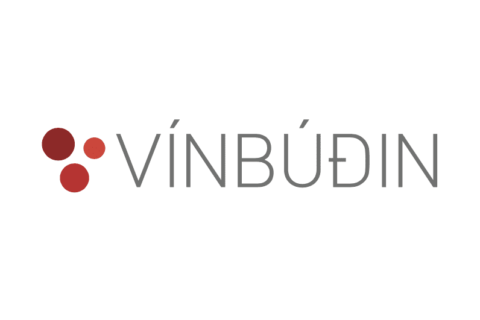
Vinbudin chain logo
You might want to be careful about the hours of operation of these stores, as they can be quite odd.
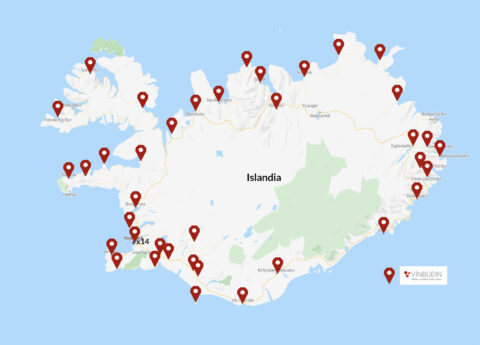
Map of Vinbudin store chain
Some advantage of this monopoly is that you can see the exact address and hours of operation of each individual store on a single page here: Vinbudin operating hours.
Iceland alcohol prices
The assortment of alcohol in Vinbudin stores depends on the size of the store, of course, but it is quite wide and very international. European (mainly Danish and German, but also British) beers, wines from all over the world, a selection of whiskeys, rums and other stronger spirits.
A local specialty is Brennivín (literally, burning wine), a potato schnapps with a caraway flavor. A small glass to a pickled shark is an interesting experience, but if you want to make the most of your visit to Iceland, use it sparsely. Also because a bottle of this fine liqueur will costs you close to $100 (in-store).
| Alcohol prices in Iceland |
| product |
Vinbudin |
Duty Free KEF
(arrivals) |
| beer, 0.5l can |
$3.90 |
$2.75 |
basic wine
red, dry |
$21.85 |
$14.45 |
| quality vodka 1L |
$78 |
$29 |
| least expensive vodka 1L |
$68 |
$25 |
Data as of February 2023. Prices converted to USD according to the exchange rate on the day of purchase.
Table: Comparison of alcohol prices in Iceland. (February 2023)How much does alcohol cost in Iceland? As you can see in the table, all types of alcohol are quite expensive, even in the duty-free store at Keflavik Airport arrivals. Prices are significantly lower at the departure zone duty-free.
If
you want to buy some local alcohol as a souvenir to take home, it’s certainly best to buy it at the duty-free store in the departure terminal There, the prices are about 30% lower compared to the arrivals terminal shop!
A beer in a restaurant (0.4l – 0.5l) costs from 1500 to 2000 ISK ($10-$15), a glass of wine about 2000 ISK (about $15).
Limits on alcohol and tobacco imports
As described above, you can bring quite a bit of food into Iceland without paying customs duties (if you’re coming from the EEA). But import of alcohol and cigarettes is governed by a different set of rules. And for these products it doesn’t matter if you’re arriving from within or outside of EEA.
As for tobacco products, the matter is relatively simple: you can bring at most 200 cigarettes or 250 g of other tobacco products without paying customs duty. You must be at least 18 years old to import them.
As for alcohol imports – it’s a bit more complicated. It seems like the general idea was to allow importing about 0.5 litre of pure alcohol in any form you prefer, but officially it is broken down to a number of alternatives.
The basic options for duty-free transportation of alcohol to Iceland are:
- 1.5 liters of strong alcohol (i.e. >21%)
- 6 bottles of wine (0.75l)
- 18 liters of beer (liters! that is, for example, 36 cans of 0.5 l)
You can choose one of these basic options or create our own combination, such as:
- 1 liter of strong alcohol, 0.75 liters of wine and 3 liters of beer;
- 4 bottles of wine and 12 0.5 l beers;
- 1 liter of strong alcohol and 6 l of beer;
- 2 bottles of wine and 12 liters of beer;
But be warned:
- strong alcohol is defined as a beverage with more than 21% pure alcohol content;
- According to information we obtained from Icelandic Customs, the strongest alcohol allowed for sale in Iceland is one with a strength of 80%, and any stronger alcohol requires a special permit should one wish to bring it into Iceland;
- any alcohol under 21% that is not beer is considered wine for the purposes of these regulations;
- in order to bring any alcohol into Iceland at all, one must be at least 20 years old;
- the above restrictions apply to the total amount of alcohol imported by an individual – including alcohol purchased on board a plane, at the airport arrival duty-free shop, carried in your carry-on and checked baggage, etc.;
- imported alcohol and tobacco products do not count towards the overall limit on the weight and value of imported food indicated earlier;
Drinking alcohol in public places in Iceland
In many popular tourist spots (such as at the Reykjadalur hot river) it is popular and acceptable to spread out a picnic and “bring your own bottle”. Also in wild hot springs in the interior (e.g. at Hveravellir or Landmannalaugar) there is no problem with this. Of course, one should always maintain culture, moderation and reason. After all, the stones in the stream won’t get any less pungent, and the boiling water in the surrounding springs will not get less hot just because you’ve had a few beers….
Limit of driver’s blood alcohol content in Iceland
In Iceland, the permissible limit of alcohol in a driver’s blood from June 2019 is two-tenths per mille (0.2‰, or 0.02%), which is the same as in most of Europe. However, there is no distinction there between ‘indicating consuption’ and ‘driving under the influence’ (which you can meet in some other countries). As soon as you cross the 0.2‰ limit, you are subject to full sanctions. Remember that the lowest (sic!) fine for a DUI in Iceland is 100,000 ISK, so over $700.
T
he locals say: Eftir einn ei aki neinn (literally: no one rides after one).
Vegan and gluten-free products in Iceland
Both vegan and gluten-free products are fairly widely available at major grocery chains. At Bonus, for example, vegan brands include Beyond Meat, Anamma and Tofurky, while gluten-free products are sold under the Semper brand. The other chains have a selection of different brands, but their selection (in large markets) is also quite wide. If you have a special diet or are concerned about avoiding certain nutrients, watch out for the labels, as they sometimes vary (i.e., they are often simply not there).
Store staff, while eager to help, may not always be able to handle the Danish label, for example. Labels are sometimes not translated, so a phone call with a translator is sometimes indispensable.
